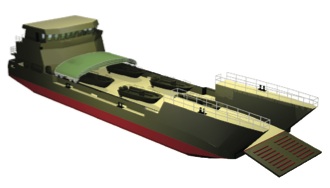Análisis de requerimientos mediante la aplicación de AHP como base para el desarrollo del diseño conceptual de un buque tipo LCU
Keywords:
landing Craft Utility (LCU), landing, preliminary design, AHPAbstract
This article summarizes the study of the requirements and necessities which are taken into consideration in the development of the conceptual design of a Landing Craft Utility (LCU), in which the AHP hierarchic analysis methodology was used, in order to qualify and classify the requested by the Colombian Navy (ARC), which will be the user of the ship. This way, it was possible to establish the importance which each of the necessities exposed has for the shipbuilder, in order to include them directly in the design process.Downloads
References
American Society for Testing and Materials, F1166-95a2000, Standard Practice for Human Engineering Design for Marine Systems, Equipment and Facilities.
David G. M. Watson, Practical Ship Design, vol. 1, Elsevier Ocean Engineering Book Series.
Holtrop, J. and G. G. Mennen, A Approximate Power Prediction Method.
Kamal M. Al-Subhi Al-Harbi (1999, 19 May), Application of the AHP in project management, Department of Construction Engineering and Management, King Fahd University of Petroleum & Minerals.
Lloyd`s Register (1999 July), Provisional Rules for the Classification of Naval Ships, vol. 1, Pt 4, cap. 2.
NATO Naval Group 6 Specialist Team on Small Ship Design (2004, May), “NATO/PfP Working Paper on Small Ship Design”, pp. 3.
Navsea, (1996, August), Naval Ship´s Technical Manual, Weights and Stability, S9086-C6-STM-010/CH-096R1.
NES 109 (2000, April) Stability Standard for Surface Ships. U. K. Ministry of Defense, Issue 1.
Reyes, Tomás (2004), “Métodos Cualitativos de investigación, los grupos focales y estudio de caso”.
Saaty, T. L. (1980), “The Analytical Hierarchical Process”, J Wiley, New York.
Saaty, T. L. (1990) How to make a decision: The Analytic Hierarchy Process. European Journal of Operational Research. North-Holland; 48: 9-26.
Tague, Nancy R. (1995), “The Quality Toolbox”, ASQC Quality Press, Estados Unidos.
The Society of Naval Architects and Marine Engineers, (1995, June) Barge Model Resistance data Sheets.
Toscano Hurtado, Gerard (2005), El proceso de análisis jerárquico como herramienta para la toma de decisiones en la selección de proveedores, Lima.

Downloads
How to Cite
Issue
Section
License
The authors who publish in this Journal certify that:
- The work submitted for publication in The Ship Science and Technology journal, was written by the author, given that its content is the product of his/her direct intellectual contribution.
- All data and references to material already published are duly identified with their respective credits and are included in the bibliographic notes and quotations highlighted as such.
- All materials submitted for publication are completely free of copyrights; consequently, the author accepts responsibility for any lawsuit or claim related with Intellectual Property Rights thereof, Exonerating of responsibility to The Science and Technology for the Development of Naval, Maritime, and Riverine Industry Corporation, COTECMAR.
- In the event that the article is chosen for publication by The Ship Science and Technology journal, the author state that he/she totally transfers reproduction rights of such to The Science and Technology for the Development of Naval, Maritime, and Riverine Industry Corporation, COTECMAR.
- The authors retain the copyright and transfer to COTECMAR the right of publication and reproduction of the work which will be simultaneously subject to the Creative Commons Attribution License (CC -BY) , which allows the license to copy, distribute, display and represent the work and to make derivative works as long as it recognizes and cites the work in the manner specified by the author or licensor.
- For more information about the Creative Commons Attribution License (CC -BY) and his use and scope, please visit the following web page https://creativecommons.org/licenses/by-sa/4.0/legalcode








